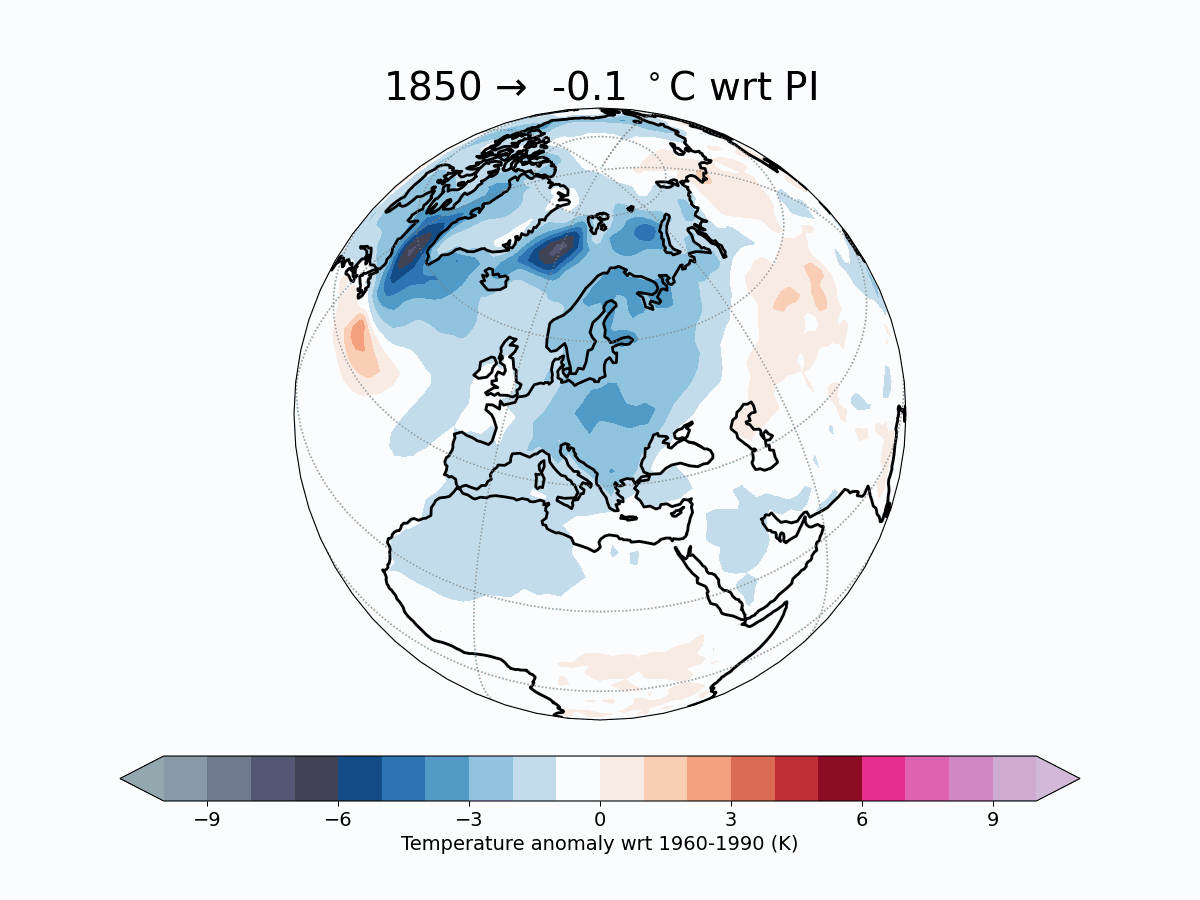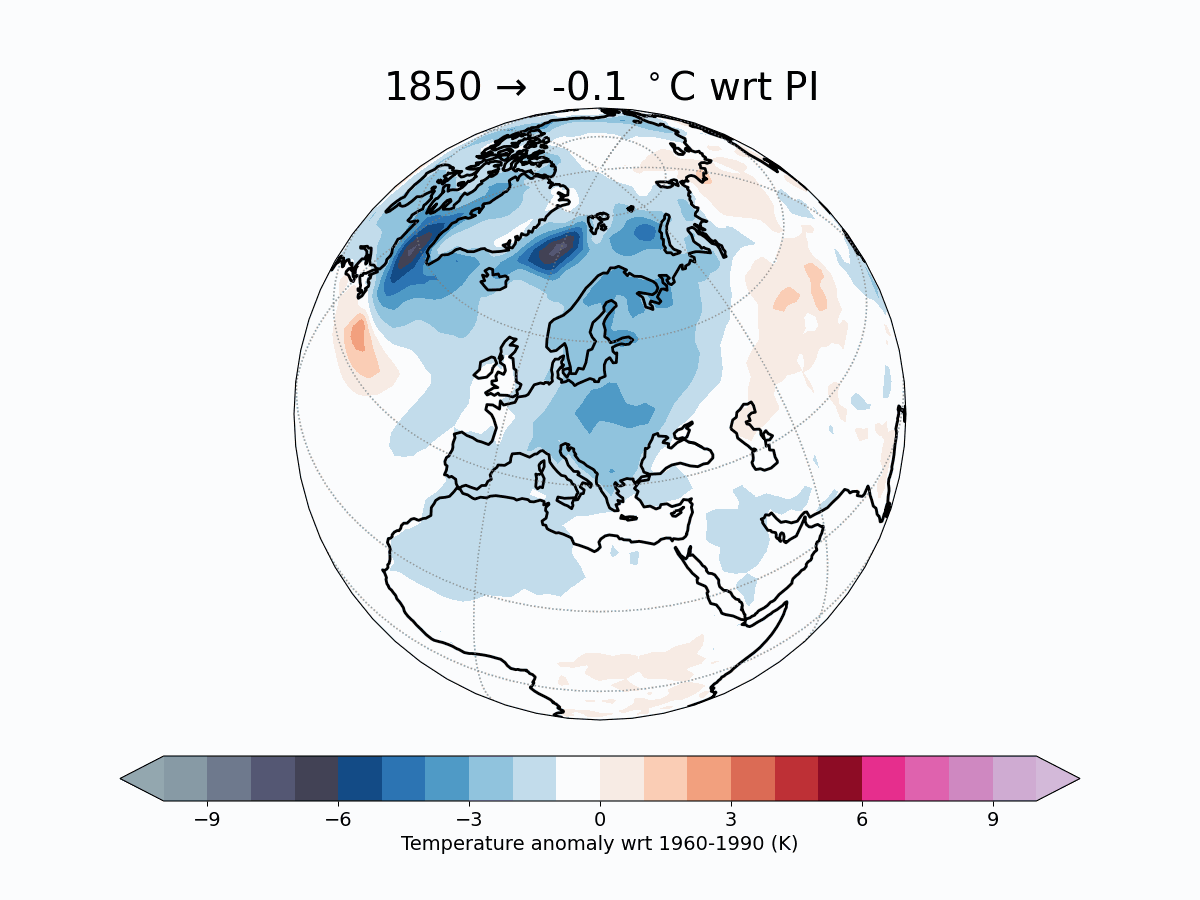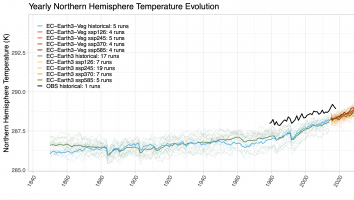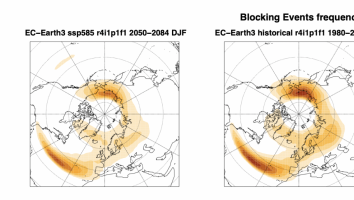The global Earth-System model EC-Earth

EC-Earth is a global coupled climate model (Hazeleger et al., 2010, 2012, Doescher et al. 2020) that is being developed by a consortium of 27 European research institutes, in which ISAC-CNR is playing a central role for the development of the model.
Ensemble simulations with EC-Earth2 (also by ISAC-CNR) contributed to the CMIP5[1] archive, and numerous studies performed with the EC-Earth model have appeared in peer-reviewed literature and have contributed to the fifth assessment report (AR5) of the IPCC (Intergovernmental Panel on Climate Change) (IPCC, 2013). EC-Earth2 was used in a wide range of studies from paleo-research to climate projections (e.g. Palazzi et al. 2013), including also seasonal (e.g. Prodhomme et al., 2016; Haarsma et al., 2019) and decadal forecasts (e.g. Guemas et al., 2013; Hazeleger et al. 2103a; 2013b; Corti et al. 2015).
In preparation for CMIP6[2], a new version of EC-Earth, namely EC-Earth3 (Doescher et al. 2020), has been developed and several climate simulations have been performed and studied during the past five years by ISAC-CNR scientists (e.g. Davini et al. 2015a,b; Davini et al. 2017a,b; Palazzi et al, 2019; Yang et al. 2019; Meccia et al. 2020)

Fig 1. Historical and ScenarioMIP projections of average global surface temperatures in the EC-Earth CMIP6 ensemble
Recent CMIP6 scenario projections with EC-Earth3 produced by ISAC-CNR are available for a large set of variables at about 80 km resolution in the atmosphere 91 levels in the vertical, and about 1 degree in the ocean, time resolutions starting from 3 hours, with two model versions: EC-Earth3 and EC-Earth3-Veg (with dynamical vegetation). Present-day (historical) and future emission scenarios which have been explored so far range from significant reduction of emissions and sustainability (SSP1-1.9, SSP1-2.6) through middle-of-the-road (SSP2-4.5) to more business-as-usual high-emission scenarios (SSP3-7.0 and SSP5-8.5, 4xCO2). The data are hosted and distributed at CINECA through a dedicated ESGF (Earth System Grid Federation) data node and model diagnostic and performance metrics are available.


In the videos above, the simulations performed with CNR-ISAC climate model EC-Earth3 shows two possible evolutions of surface temperature as a function of different level of greenhouse gases emissions. Those simulations are run from the 1850, where the human impact on climate was negligible, to year 2100. To the left, an optimistic scenario (known as SSP1-2.6) where the global emissions are reduced starting in 2020, leads to a moderate increase of global mean temperatures. To the right, a scenario without mitigation (namely SSP5-8.5) where the emission grows massively in the 21st century, leads to more than 6 degrees of global warming. You may note that, due to the earth system dynamics, warming in the European region will be larger than the global signal.
An additional archive of ensemble simulations with EC-Earth 3.1 at high horizontal resolution, up to 16 Km -consistent with HighResMIP protocol (Haarsma et al. 2016, 2020) - is available (SPHINX) and is useful for evaluating the impact of model resolution on future projections of extremes.
EC-Earth is now focusing on the next generation of the model, EC-Earth4, which will be based on OpenIFS, allowing a more widespread adoption of the model, for training and research purposes, a faster update cycle and improved research feedbacks between EC-Earth and ECMWF.

Fig. 2: Changes in atmospheric blocking event frequency for EC-Earth3 (the ISAC-CNR ensemble member) between the historical period and a SSP5-8.5 projection.
References
Corti S., Tim Palmer, Magdalena Balmaseda, Antje Weisheimer, Sybren Drijfhout, Nick Dunstone, Wilco Hazeleger, Jürgen Kröger, Holger Pohlmann, Doug Smith, Jin-Song von Storch, and Bert Wouters, 2015: “Impact of Initial Conditions versus External Forcing in Decadal Climate Predictions: A Sensitivity Experiment.” J. Climate, 28, 4454–4470.doi: http://dx.doi.org/10.1175/JCLI-D-14-00671.1
Davini P., J. von Hardenberg and S. Corti, 2015: “Tropical origin for the impacts of the Atlantic Multidecadal Variability on the Euro-Atlantic climate.” Env. Res. Let. doi:10.1088/1748-9326/10/9/094010
Davini, P., von Hardenberg, J., Filippi, L. and Provenzale, A. ( 2015), Impact of Greenland orography on the Atlantic Meridional Overturning Circulation. Geophys. Res. Lett., 42: 871– 879. doi: 10.1002/2014GL062668.
Davini, P., von Hardenberg, J., Corti, S., Christensen, H. M., Juricke, S., Subramanian, A., Watson, P. A. G., Weisheimer, A., and Palmer, T. N., 2017: Climate SPHINX: evaluating the impact of resolution and stochastic physics parameterisations in the EC-Earth global climate model, Geosci. Model Dev., 10, 1383-1402, doi:10.5194/gmd-10-1383-2017.
Davini P., S. Corti, F. D’Andrea, G. Riviere, J. von Hardenberg 2017, Improved winter European atmospheric blocking frequencies in high-resolution global climate simulations, J. Adv Model Earth Sy. 9, 2615–2634. https://doi.org/10.1002/2017MS001082.
Doescher et al. 2020, EC-Earth in CMIP6, to be submitted to GMD.
Guemas, V., S. Corti, J. García-Serrano, F. Doblas-Reyes, M. Balmaseda, and L. Magnusson, 2013: “The Indian Ocean: the region of highest skill worldwide in decadal climate prediction.” J. Climate. 26, 726-739 doi:10.1175/JCLI-D-12-00049.1
Haarsma R.J. , M. Roberts, P. L. Vidale, C. A. Senior, A. Bellucci, Q. Bao, P. Chang, S. Corti, N. S. Fučkar, V. Guemas, J. von Hardenberg, W. Hazeleger, C. Kodama, T. Koenigk, L. R. Leung, J. Lu, J.-J. Luo, J. Mao, M. S. Mizielinsk, R. Mizuta, P. Nobre, M. Satoh, E. Scoccimarro, T. Semmler, J. Small, and J.-S. von Storch, 2016: High Resolution Model Intercomparison Project (HighResMIP v1.0) for CMIP6. Geosci. Model Dev., 9, 4185–4208, doi:10.5194/gmd-9-4185-2016
Haarsma, R.J., García-Serrano, J., Prodhomme, C. et al. Sensitivity of winter North Atlantic-European climate to resolved atmosphere and ocean dynamics. Sci Rep 9, 13358 (2019). https://doi.org/10.1038/s41598-019-49865-9
Haarsma, R, M Acosta, R Bakhshi, P-A Bretonnière, L-P Caron, M Castrillo, S Corti, P Davini, E Exarchou, F Fabiano, U Fladrich, R Fuentes, J García-Serrano, J von Hardenberg, T Koenigk, X Levine, V Meccia, T van Noije, G van den Oord, F Palmeiro, M Rodrigo, Y Ruprich-Robert, P Le Sager, E Tourigny, S Wang, M van Weele and K Wyser, 2020: HighResMIP versions of EC-Earth: EC-Earth3P and EC-Earth3P-HR. Description model performance, data handling and validation. 2019 Geosci. Model Dev., submitted. https://doi.org/10.5194/gmd-2019-350
Hazeleger W., B. Wouters, G.J. van Oldenborgh, S. Corti, T. Palmer, D. Smith, N. Dunstone, J. Kröger, H. Pohlmann, J.-S. von Storch 2013 “Predicting multi-year North Atlantic Ocean variability.” J. Geophys. Res. Ocean – DOI:10.1002/jgrc.20117
Hazeleger, W., V. Guemas, B. Wouters, S.Corti, I. Andreu-Burillo F.J. Doblas-Reyes, K. Wyser, and M. Caian, 2013: “Multiyear climate predictions using two initialisation strategies”. Geoph. Res. Lett.. DOI: 10.1002/grl.50355
Hazeleger, W., Severijns, C., Semmler, T., Ştefănescu, S., Yang, S., Wang, X., ... and Bougeault, P., 2010. EC-Earth: a seamless earth-system prediction approach in action. Bulletin of the American Meteorological Society, 91(10), 1357-1364.
Hazeleger, W., Wang, X., Severijns, C., Ştefănescu, S., Bintanja, R., Sterl, A., ... and Van Noije, T. 2012. EC-Earth 745 V2.2: description and validation of a new seamless earth system prediction model. Climate dynamics, 39(11), 2611-2629
IPCC, 2013: Climate Change 2013: The Physical Science Basis. Contribution of Working Group I to the Fifth Assessment Report of the Intergovernmental Panel on Climate Change [Stocker, T.F., D. Qin, G.-K. Plattner, M. 750 Tignor, S.K. Allen, J. Boschung, A. Nauels, Y. Xia, V. Bex and P.M. Midgley (eds.)]. Cambridge University Press, Cambridge, United Kingdom and New York, NY, USA, 1535 pp, doi:10.1017/CBO9781107415324, 2013.
Meccia, V. L., Fabiano, F., Davini P., & Corti S. 2020. Stochastic parameterizations and the climate response to external forcing: An experiment with EC‐Earth. Geophysical Research Letters, 47, e2019GL085951. https://doi.org/10.1029/2019GL085951
Palazzi, E., von Hardenberg, J., and Provenzale, A. ( 2013), Precipitation in the Hindu‐Kush Karakoram Himalaya: Observations and future scenarios, J. Geophys. Res. Atmos., 118, 85– 100, doi: 10.1029/2012JD018697.
Palazzi, E., Mortarini, L., Terzago, S. et al. 2019 Elevation-dependent warming in global climate model simulations at high spatial resolution. Clim Dyn 52, 2685–2702. https://doi.org/10.1007/s00382-018-4287-z
Prodhomme, C., L. Batté, F. Massonnet, P. Davini, O. Bellprat, V. Guemas, and F.J. Doblas-Reyes, 2016: Benefits of Increasing the Model Resolution for the Seasonal Forecast Quality in EC-Earth. J. Climate, 29, 9141–9162, https://doi.org/10.1175/JCLI-D-16-0117.1
Yang, C., Christensen, H.M., Corti S., von Hardenberg J. and Davini P., 2019. The impact of stochastic physics on the El Niño Southern Oscillation in the EC-Earth coupled model Clim Dyn 53: 2843. https://doi.org/10.1007/s00382-019-04660-0
[1] https://www.wcrp-climate.org/wgcm-cmip/wgcm-cmip5
[2] https://www.wcrp-climate.org/wgcm-cmip/wgcm-cmip6


